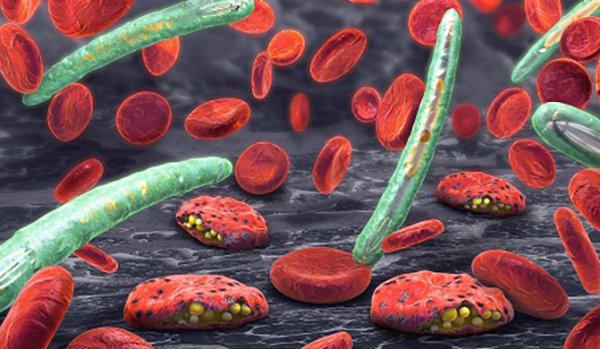It takes a nanoparticle, says a team of University of Buffalo (UB) scientists, to raise a transmission-blocking vaccine that will more effectively curb the spread of malaria. This nanoparticle is a liposome-based system that serves as an adjuvant, a vaccine helper. It is a platform, really, one that becomes studded with vaccine antigens, improving their display, enhancing their ability to induce an immune response.
The platform’s secret is a polyhistidine-tag, a small chain of amino acids that attaches to a malaria vaccine’s antigen, a protein called Pfs25. Once his-tagged antigens insert themselves into a nanoparticle, the his-tags are snug in the nanoparticle’s surface, with the antigens sticking out like pins in a pin cushion.
Curiously, this his-tagged construct doesn’t directly prevent an immunized person from becoming infected. Instead, it helps reduce the odds that people living in that person’s community will get malaria. Immunized people transmit antimalarial proteins to the insects that bite them, breaking the mosquito-human infection cycle and thereby curbing the spread of disease.
Details about the Pfs25-tag-nanoparticle construct appeared recently in the journal Nature Nanotechnology, in an article titled, “A malaria vaccine adjuvant based on recombinant antigen binding to liposomes.” The article describes, for example, how his-tagged Pfs25 can be mixed at the time of immunization with preformed liposomes containing cobalt porphyrin–phospholipid. Mixing these components together, the article’s authors indicated, results in “spontaneous nanoliposome antigen particleization (SNAP).”
“Pfs25 is a malaria transmission-blocking vaccine antigen candidate, but its apparently limited immunogenicity in humans has hindered clinical development,” the UB scientists noted. To address these shortcomings, they deployed SNAP, which allowed antigens to be “stably presented in uniformly orientated display via his-tag insertion in the cobalt porphyrin–phospholipid bilayer, without covalent modification or disruption of antigen conformation.”
A few malarial transmission-blocking vaccines have shown promise, but they have not been widely tested due to unwanted side effects or limited effectiveness. The new transmission-blocking vaccine developed by the UB team, if successful, could help reduce the spread of malaria, which kills more than 400,000 people annually, mostly small children in sub-Saharan Africa.
“Malaria is a huge global problem,” says the study's lead author, Jonathan Lovell, Ph.D., associate professor of biomedical engineering. “This approach—using a transmission-blocking vaccine—could be part of a suite of tools that we use to tackle the disease.”
The development of effective transmission-blocking vaccines—combined with bug nets, insecticides, anti-parasitic drugs, and other types of vaccines—could help break the vicious human-mosquito infectious cycle.
Prior research in this area has focused on techniques like genetic engineering and chemical binding of toxin proteins to boost transmission-blocking vaccine responses. Each strategy has potential, but they're also time- and resource-consuming. The biotechnology created by the UB-led research team differs in its relative ease of assembly and overall effectiveness, Dr. Lovell asserts.
In tests involving mice and rabbits, researchers showed that when the SNAP platform was deployed, antibodies from Pfs25 effectively blocked the development of malaria-causing parasites inside the gut of mosquitoes. Additional tests paired the adjuvant with multiple malaria antigens, suggesting its promise for blocking the spread of malaria at numerous stages of the disease.
“SNAP immunization of mice and rabbits is well tolerated with minimal local reactogenicity, and results in orders-of-magnitude higher functional antibody generation compared with other ‘mix-and-inject’ adjuvants,” the article’s authors wrote. “Serum-stable antigen binding during transit to draining lymph nodes leads to enhanced antigen uptake by phagocytic antigen-presenting cells, with subsequent generation of long-lived, antigen-specific plasma cells.”
The research team's next step is to prepare additional experiments that will justify moving the technology into human trials.







